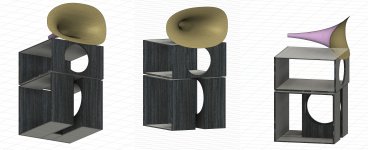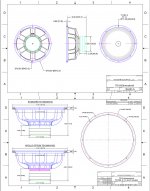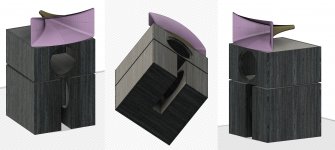Thanks Docali! I would love to show off the HvDiff but I don't know how to get the horn into Fusion360...I don't have a PLY file for the horn with round over...the only place the horn is complete is within ABEC.
You can export the mesh from ABEC I have seen it done but I can't tell you how.
The Arturia Card looks interesting, more geared towards recording. MOTU have made hardware for a long time and have a good reputation like RME.
The Arturia Card looks interesting, more geared towards recording. MOTU have made hardware for a long time and have a good reputation like RME.
Here is the horn before the roll over. The o-axis of this horn, set up like this, adds ~2" of height
Attachments
Last edited:
Optically, I would prefer the first version but the first horn seems to have a smaller mouth: It's already some time ago when I created them.
@camplo
It would be interesting what is the optical effect of this radial type horn on top of your woofer chassis.
View attachment drba_rad_200_mk1.zip
It would be interesting what is the optical effect of this radial type horn on top of your woofer chassis.
View attachment drba_rad_200_mk1.zip
You know I'm dying to be your lab rat lol....If you are saying you prefer the looks of the swh160...the swh160 would fit nice into a box. Don K may or may not be finishing the swh160 round over...then again, the bi radials might not need a round over if fitted to a box...just the tapered edge of the box maybe?....the other horn pic is actually the swh160 scaled down...
I told Don and now I'm telling you, the completion of the HvDiff, really is a milestone. The work you guys did on my behalf, its very endearing, to say the least. My services as horn fabrication or maybe I can ship you guys my 3d printer after I've got my set rolling...or send me some projects to solve...if someone says anything bad about you, I'll beat em up....I think you get the idea, you guys invested in me, I would like to return the favor <3
Learning AKABAK doesn't seem impossible...with some hints from Don K I may be able to transfer the Rollover style from HvDiff to other horns, or create my own, and run sims.
When I get a chance I'll load in the horn and do a photoshoot, I gotta get some things in order for my first day back to work, they are sending me to start the season paving with a Lansing crew, tonight...then when they are done with me, I'll be back with my normal crew, working within a ~162 mile radius of Grand Rapids, Mi...hopefully the virus will make for a slow year, we just got a pay raise after voting out the union, I'm a fan of making more money per hour and working less of them once you hit a decent annual lol
I told Don and now I'm telling you, the completion of the HvDiff, really is a milestone. The work you guys did on my behalf, its very endearing, to say the least. My services as horn fabrication or maybe I can ship you guys my 3d printer after I've got my set rolling...or send me some projects to solve...if someone says anything bad about you, I'll beat em up....I think you get the idea, you guys invested in me, I would like to return the favor <3
Learning AKABAK doesn't seem impossible...with some hints from Don K I may be able to transfer the Rollover style from HvDiff to other horns, or create my own, and run sims.
When I get a chance I'll load in the horn and do a photoshoot, I gotta get some things in order for my first day back to work, they are sending me to start the season paving with a Lansing crew, tonight...then when they are done with me, I'll be back with my normal crew, working within a ~162 mile radius of Grand Rapids, Mi...hopefully the virus will make for a slow year, we just got a pay raise after voting out the union, I'm a fan of making more money per hour and working less of them once you hit a decent annual lol
The Arturia Card looks interesting, more geared towards recording. MOTU have made hardware for a long time and have a good reputation like RME.
RME's reputation is practically unmatched as far as driver support and long term reliability are concerned. OTH, the audio quality of the BB equipped Audient and PreSonus interfaces appears to be impressive, though the GUI of the latter is an item for debate.
RME's reputation is practically unmatched as far as driver support and long term reliability are concerned. OTH, the audio quality of the BB equipped Audient and PreSonus interfaces appears to be impressive, though the GUI of the latter is an item for debate.
yes but I need 6 outputs...
Countersinking the woofer would make the mounting baffle less stiff, counterproductive.Some advice welcome...for the slot load...I can simplify things by not countersinking the woofer...shouldn't be an issue, being that they are buried in the slot....right?
Whether the woofer was countersunk would have some effect on the slot resonance, determined by the slot chamber's depth, width and volume- countersinking would reduce the volume slightly.
At any rate, those issues are easily corrected with EQ, while the polar response inherent with your horn and mid cone position choice can't be corrected with EQ other than at one position.
- Can you elaborate please? Do I have some other options for positioning?while the polar response inherent with your horn and mid cone position choice
The horn you depict would have a "beamy" horizontal dispersion pattern, under 45 degrees above around 5kHz, widening to around 90 degrees at 1kHz, increasing to 180 degrees below 500 Hz. Equalized for "flat" response on axis, the horn will lack upper response off axis, no options will fix that other than a different horn choice.
The acoustic point of origin for the HF driver is roughly at the horn throat, for the mid driver, near the apex of the cone/dome. The path length difference can be corrected by delaying the HF signal to the time of flight, which appears to be around 2.5ms.
That delay would correct for the acoustic point of origin discrepancy on axis, but at off axis angles the apparent physical center to center distance will still result in wave interference, "peaks and troughs", "lobes", "comb filtering".
Options to correct the physical point of origin problem are either to move the HF driver forward, or the mid driver rearward. Those options could include using a separate mid horn, or the mid driver sharing the HF horn.
Art
The acoustic point of origin for the HF driver is roughly at the horn throat, for the mid driver, near the apex of the cone/dome. The path length difference can be corrected by delaying the HF signal to the time of flight, which appears to be around 2.5ms.
That delay would correct for the acoustic point of origin discrepancy on axis, but at off axis angles the apparent physical center to center distance will still result in wave interference, "peaks and troughs", "lobes", "comb filtering".
Options to correct the physical point of origin problem are either to move the HF driver forward, or the mid driver rearward. Those options could include using a separate mid horn, or the mid driver sharing the HF horn.
Art
Last edited:
The horn you depict would have a "beamy" horizontal dispersion pattern, under 45 degrees above around 5kHz, widening to around 90 degrees at 1kHz, increasing to 180 degrees below 500 Hz. Equalized for "flat" response on axis, the horn will lack upper response off axis, no options will fix that other than a different horn choice.
From what do you draw these over-precise conclusions? From the picture?
I tried to be general, rather than over-precise, as the picture looks just like horns with the response I described :^).From what do you draw these over-precise conclusions? From the picture?
The dimensions can be inferred from the size of the drivers discussed.
To put it simply, you won't hear much high end from an exponential (like) horn if you can't see the throat- they "beam".
Whether beaming is a desirable feature is up to the user to decide.
Art
From what do you draw these over-precise conclusions? From the picture?
What weltersys is saying is :
1) The horn is not CD
2) Its not a coax driver, or a Unity horn
I'm concluding that weltersys feels a point source or pseudo point source is the way to go.
I think he is trying to save you about 3-7 years of work and reading, but knows you may have to get there the hard way?😀
I think he is trying to save you about 3-7 years of work and reading, but knows you may have to get there the hard way?😀
Very well stated.
To put it simply, you won't hear much high end from an exponential (like) horn if you can't see the throat- they "beam".
Art
Also well put and quite correct.
Agree with Art, lbstyling and Earl. camplo, have we not been through this before?
Maybe I missed it but are you going to use digital XO and time align the drivers?
Maybe I missed it but are you going to use digital XO and time align the drivers?
- Home
- Loudspeakers
- Multi-Way
- Is it possible to cover the whole spectrum, high SPL, low distortion with a 2-way?


